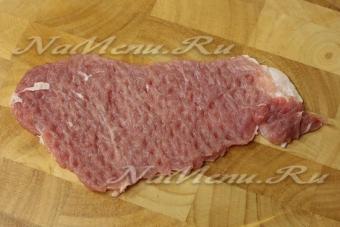Methods for determining quality welds carried out in accordance with building standards and specifications. Current weld inspection techniques provide the ability to detect almost any flaw that occurs during welding.
The following standards for welds determine the conditions for assessing the quality of welds that are made using arc, argon, electroslag and gas welding.
The standards for determining the quality are adopted according to the following checks.
Visual and measuring control.
When visual and measuring inspection of welds is not allowed:
1. Cracks of any type and direction.
2. Lack of penetration between the base metal and the seam, as well as between the beads of the seam.
3. Lack of penetration at the root of the seam.
4. Influxes and smudges, splashes of metal.
5. Unsealed craters.
7. Burns.
8. Clusters.
9. Undercuts.
10. Deviations in the size of the seam above the accepted standards.
The norms of permissible flaws discovered during the visual and measuring inspection.
capillary control.
When checking the weld by indicator prints, elongated and non-single indicator prints are not allowed. The total number of single rounded indicator prints should not exceed the norm for welds for single inclusions, and the maximum size of each indicator print should not exceed three times the value of these standards. Defects noticed during the test may be evaluated by their actual result after washing off the reagents. In this case, it is necessary to adhere to the requirements of visual and measuring inspection of welds.
Magnetic particle control.
The standards for quality assessment during magnetic particle inspection should be consistent with the standards for visual inspection. The flaws noticed during the verification process can be assessed by their actual size after washing off the emulsion or powder.
radiographic control.
The quality of welds is acceptable if various lack of penetration, cracks, burns, fistulas, inadmissible convexity and concavity of the root of the weld are not detected on the radiographic image, and the size, number and total area of single inclusions and clusters does not exceed the standards shown in the table below.
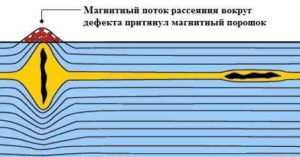
Ultrasonic control.
The quality of welds is acceptable under the following conditions:
1. The observed discontinuities are not elongated.
2. The gap along the scanning plane between two adjacent discontinuities should not be less than the conditional length of discontinuities with a large value of this indicator.
3. The equivalent area and the number of single discontinuities should not exceed the standards specified in the RD.
Mechanical tests.
The quality of welds according to the results of mechanical inspection is acceptable under the following conditions:
1. The tensile strength must have indicators not lower than the minimum indicators for this metal product. And when checking welds with different values of temporary resistance, this indicator should not be less than the minimum allowable for a less durable metal.
2. The bending angle during the static bending test and the gap between the compression planes, when checking the flattening of the welding joints of pipes with an outer diameter of less than 108 mm and a wall thickness of less than 12 mm, should be in accordance with the standards.
3. Impact strength in the process of testing for impact bending of specimens of type VI according to GOST 6996-66 with a notch along the seam must be at least:
a) 49 J / cm 2 (5 kgf-m / cm 2) for high-alloy martensitic-ferritic and pearlitic steels.
b) 69 J / cm 2 (7 kgf-m / cm 2) for austenitic chromium-nickel steels.
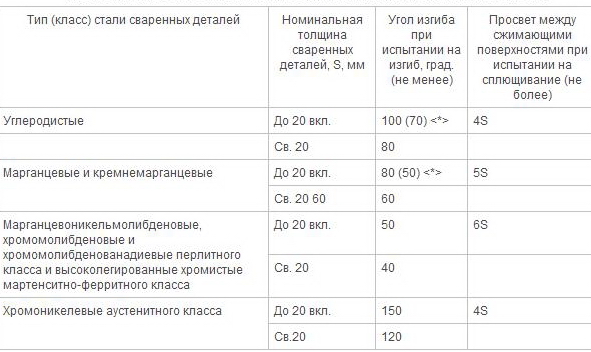
Metallographic studies.
The standards for evaluating the quality of welds based on the results of a metallographic inspection must be in accordance with the conditions of the ND. Along with this, inadmissible flaws are the defects indicated in the second figure.
Today, welding is a very popular type of connection. It is applicable for small parts, and for large products, and for mass buildings, and with varying degrees of complexity. The technology of welding of metal structures allows the use of absolutely any type of joints: corner, tee, overlap or end. And that's not all, because technologies do not stand still, they develop, which means that welding itself is becoming more advanced.
Requirements for welding metal structures
Today, welding work has its own nuances. It is one thing when an amateur is engaged in welding at home, and quite another when there is a professional metal production. In the second case, the quality of work will depend on many factors.
There are certain sections that govern the entire technology:
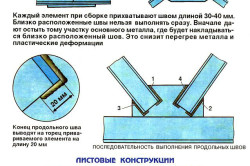
- SNIP II 23-81 and GOST 27772-88. This section is dedicated to the details. It describes in detail the possibility of using certain metals for structures, geometric shapes, strength categories, as well as the weldability of each metal.
- There is a section dedicated to diagrams. Here you can get acquainted with how to properly create seams, because the strength of the entire structure depends on their quality. Depending on the number of parts to be welded, the very complexity of the work will depend.
- Welding qualification. There are levels of work that even a beginner can do, but there are categories that only a professional welder can handle. A more detailed list can be found in document RD 15.132-96 of the Ministry of Fuel and Energy of the Russian Federation.
- Welding control. According to this parameter, a section of any GOST for welding metal structures is qualified.
Of course, these standard requirements are more related to the professional level of welding, but if there is a desire to develop in this area, then it would not be out of place for a simple beginner to get acquainted with this. In addition, these documents will help to correctly determine the material for the structure, the type of connection, the people who will be able to perform certain types of welding, and determine the control over welding itself.
If a beginner or just an amateur takes up this question, then you can use the help of a designer.
Classical technology of welding of metal structures
If we act the old fashioned way, then this technology will use only two sources of energy: an electric arc and a gas flame.
Both arc and gas welding make a seam in three ways:
- with your own hands;
- automatically;
- semi-automatically.

Welding schemes: a - back in a stepped way; b - by the "double layer" method; in - a slide; g - cascade.
Regarding the first mode, there are a few things to note. In this option, all work is done manually. That is, it is self-forming. Weld, the process of welding and electrode supply is controlled. This method uses the technology of simple electric arc welding, submerged arc welding, welding-brazing using a gas welding machine. But here there is immediately a nuance that manual welding is acceptable only in household use.
Automatic welding is so named because the entire process of welding seams is carried out without human intervention. The device itself has a special mechanism, which is adjusted each time depending on the type of operation required. Each model of such automation has its own limitations, which are mainly indicated in the instructions for the technique. Most of all, automatic welding is used in mass production, since, thanks to it, the cost of such work with metal becomes quite low.
Such a device allows you to work with, apply electroslag welding, all possible options manual type. Regarding the last option, it is immediately worth noting that the operator is replaced by a robot.
The semi-automatic version has its own peculiarity. In this case, the seam is applied manually, but the wire or electrodes are automatically fed. This technology allows you to increase the level of productivity several times. And the most convenient thing about such devices is that they combine all the methods of automation and manual technologies. That is why this mode is popular among both "home" craftsmen and professionals.
Innovations in welding technology
Today the world does not stand still and is constantly evolving in all directions. The same applies to welding processes. This includes the use of a laser, and the thermal effect of friction, and the strength of the electron beam, and ultrasound.
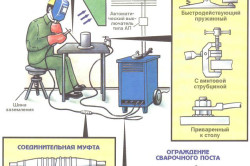
Each of the new products helps operators to work with metal structures faster and easier. The following technologies are especially popular:
- thermite;
- plasma;
- electron beam.
Each technology has its own characteristics, due to which it is used in production.
The first type is applicable for welding and installation of metal structures, when the contours of the seams of parts are processed with a special mixture, which is introduced into the joints during combustion. The convenience of this technology lies in the fact that it even allows you to work with cracks in structures. For this, the method of "influx" of metal is used.
Plasma technology is used only with the use of ionized gas, which is passed between two electrodes. The gas itself acts as an electric arc, but the effect itself is much stronger. With the help of superheated gas, metal of absolutely any thickness is melted, while it is possible, if necessary, to cut it. Thus, a multifunctional, automatic welding system is created around the plasma generator.
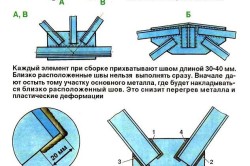
The latest technology allows you to work with deep seams, up to 20 cm. But in this case, the following ratio of the beam immersion depth and seam width should be present - 20:1. But for electron-beam technology, the presence of a vacuum is important. Accordingly, it is very difficult to use such a generator in household use. Therefore, they are used only in highly specialized areas.
As is clear from the foregoing, each type of welding is applicable in a particular area of \u200b\u200bwork. For example, it is not rational to use automatic equipment for "home" welding. It is quite expensive, which means that it will take too long to pay off. But for the same farm work, for example, the construction of a hangar or other similar building, semi-automatic or automatic is just a separate option.
Structural welding: features
Welding technology is applicable not only to metal, it can also be used with plastic and other polymers. Welding itself implies such a process during which melting and deformation of individual working parts occur, after which they are combined into a single whole.
Welding works have two main stages: assembly and connection.
The first stage is quite complicated and at the same time laborious. For the final design to be truly reliable, it is necessary that all requirements are met in the proper order. If you objectively evaluate, then it is the assembly of the structure that accounts for more than half of the total time spent.
But to speed up the whole process, you just need to use a number of recommendations.
How to ensure the correct assembly of the structure?
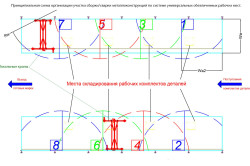
Observing certain requirements put forward for the assembly of structures, high-quality performance of all further work is ensured:
- When choosing details, you should adhere to all the dimensions that were originally laid down in the project. Otherwise, the design will at least have an inappropriate appearance, and at the maximum, will not fulfill its direct functional purpose.
- Focusing on the initial project, all elements must be in place.
- The size of the gaps also plays a very important role. If they are made more, then this will significantly affect the strength of the product, and if less, then this can lead to malfunctions of movable parts.
- Since there are always corners in the design, they should be controlled using special tools. It is very important that during the assembly process all the angles between the planes are straight, where necessary. In the opposite case, this threatens to skew the entire structure, and even such a product at a great moment can develop like a house of cards.
- It is very important to ensure butt joints space for allowable displacement of elements.
All these points are very important to take into account and control throughout the assembly, especially if welding will be carried out automatically. After all, hand-made welding in the process of performing work can be corrected, which is very difficult to do with automation. Although automatic welding is convenient in that it eliminates the influence human factor, which means that there will be much less errors in the finished design.
Positive aspects of welding
In addition to the fact that welding significantly saves time, and the seam itself comes out much better, it also has other positive characteristics:
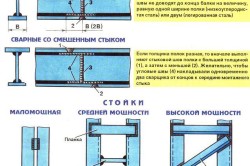
- Since only two working elements are involved in this process, without any additions, the mass of the finished soldering remains the same as it was originally. It also saves working material.
- Welding has no restrictions on the thickness of the material. It all depends on the use of a particular device.
- The variety of modern welding machines allows you to work with absolutely different materials, while they provide a high quality weld, even if the work was done with such a complex metal as aluminum.
- During welding, it is very easy to control and, if necessary, correct the shape of finished structures.
- A very important advantage is the saving of financial resources and time spent on the work.
- How harder type welding, the more difficult it is possible to perform the type of construction. At the same time, it is possible to use cast or stamped parts, and the type of metal does not make much difference, whether it is aluminum or steel.
- The welding equipment itself today is quite affordable both in terms of price and in terms of the possibility of its purchase. At the same time, with the selection of the right technology, you can have a high performance indicator.
- If desired, there is always the opportunity to create a production line type.
- If there is a desire and opportunity, you can create a structure using non-standard materials: ultra-pure metals, aluminum or steel alloys, etc.
- If it becomes necessary to work with small parts, welding will not interfere with this. It applies to them too.
- Welding works are also used for the purpose of repair. This allows you to quickly return the mechanisms and equipment to "life activity".
- If, then you can be sure that all joints will have high tightness. Of all the methods of connecting elements, only welding has the highest rate for this characteristic.
Additional points
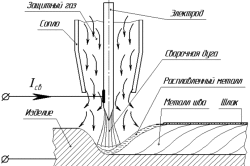
But in order for all work to be carried out efficiently and at the proper level, it is important to comply with all requirements for the technology of production of metal structures.
Properly selected equipment and its components will ensure high quality seams. Otherwise, not only the connections, but the entire finished structure may have an unpresentable appearance.
Most importantly, incorrect seams threaten the occurrence of unpleasant situations: they can disperse, burst, crack. And this, in turn, will lead to additional repairs. And it’s good if no one suffers from such a “defect”, but the opposite can also happen.
That is why, before undertaking independent welding, it is better to consult on this issue with the relevant specialists.
Ministry of Fuel and Energy of the Russian Federation
(Ministry of Fuel and Energy of Russia)
State Committee of the Russian Federation for Housing and Construction Policy (Gosstroy of Russia)
Approved
Ministry of Fuel and Energy of Russia
March 14, 1996 Approved
Ministry of Construction of Russia
May 20, 1996
Guidance Document
RD 34 15.132-96
Welding and quality control welded joints metal structures
buildings in the construction of industrial facilities
BBK 38.634
C24
UDC 69.057.4:621.791.052:658.562
Developer JSC "Orgenergostroy"
Compiled by: S.S. Jacobson, Ph.D. tech. sciences; N.D. Kurnosova, Ph.D. tech sciences; G.S. Zislin, Ph.D. tech sciences; M. L. Elyash, Ph.D. tech. Sciences
Approved by Deputy Minister of Fuel and Energy of the Russian Federation Yu.N. Korsun on March 14, 1996 and Deputy Minister of Construction of the Russian Federation S.I. Poltavtsev 05/20/96
The guiding document (RD) defines the organization and technology of welding operations in the construction of metal structures of buildings of industrial facilities, as well as the scope, control procedure and standards for assessing the quality of welded joints.
RD 34 15.132-96 covers the following types of welding: manual arc stick electrodes, mechanized (semi-automatic) welding with self-shielded flux-cored wire and in carbon dioxide, automatic and mechanized submerged arc welding.
RD 34 15.132-96 is designed for workers involved in welding and assembling large construction projects
1. GENERAL
1.1. Purpose and scope
1.1.1. This guidance document (RD) is intended for personnel involved in assembly and welding operations during the enlargement and installation of metal structures of buildings of industrial facilities.
Fulfillment of the requirements of this RD on the organization and technology of assembly and welding of metal structures ensures the production of welded joints that meet the quality indicators established by the standards, with minimal labor costs. RD is a guiding document in the development of projects for the production of works and other technological documentation.
1.1.2. The RD applies to manual arc welding with stick electrodes, mechanized (semi-automatic) welding with self-shielded flux-cored wire and in carbon dioxide, automatic and mechanized submerged arc welding in conditions of a construction and installation site.
1.1.3. This RD defines the technology of assembly and welding operations during the enlargement and installation of metal structures made of carbon and low alloy steels in accordance with GOST 27772:
shaped steel (corners, I-beams, channels) - from steel C235, C245, C255, C275, C285, C345, C345K, C375;
sheet, universal rolled products and bent profiles - from steel S235, S245, S255, S275, S285, S345, S345K, S375, S390, S390K, S440.
The designation of steels according to GOST 27772 (by yield strength) and the corresponding steel grades according to other applicable standards are given in Appendix 1.
The RD operates in conjunction with the following regulatory and technical documents (NTD):
SNiP 3.03.01-87. Bearing and enclosing structures;
SNiP II-23-81*. Design standards. Steel structures. M., 1991.
1.1.4. The guidance document contains the main provisions for the organization of welding work at construction sites, instructions on the choice of welding materials and equipment;
requirements for assembly and welding of structural elements, welding modes, control procedure and standards for assessing the quality of welded joints.
In addition, this RD gives recommendations on the technology of welding of individual typical, most common assemblies of steel structures.
1.2. Qualification requirements for welders, inspectors and engineers
1.2.1. Welding of metal structures of buildings of industrial facilities should be carried out by welders who have certificates for the right to perform the relevant welding work, issued to them in accordance with the requirements of the "Rules for the certification of welders" approved by the Gosgortekhnadzor of Russia.
Welding of structures made of steels with a yield strength of 390 MPa (40 kgf / mm2) or more is allowed for welders who have a certificate for the right to work on welding these steels.
Welders-operators who have completed a special course of theoretical and practical training and have passed tests for the right to perform these works are allowed to mechanized welding methods.
Welders of all specialties and qualifications must pass tests for the 2nd qualification group in electrical safety. In addition, all welders must pass fire and safety tests.
1.2.2. A welder who starts welding for the first time in this organization must, before being allowed to work, regardless of whether he has a certificate for the right to perform the relevant work, weld test (permissive) samples. Welding of test specimens should be carried out under conditions identical to those in which the structures will be welded.
The design and number of test samples are established by the welding supervisor, depending on the types of production joints and the qualifications of the welder. The quality of test welded joints is determined by visual inspection to determine the continuity and formation of the seam, and if necessary (at the discretion of the welding supervisor) - using non-destructive physical control methods.
The quality of test welded joints must be evaluated according to the standards provided for the same industrial joints. Test joints must be identical or of the same type with respect to those production joints that will be welded by the tested welder. The characteristic of the same type of welded joints is given in the "Rules for the certification of welders".
1.2.3. Welders are allowed to those types of work that are indicated in the certificate. The certificate must list the steel grades or groups of steel grades in accordance with the "Rules for the certification of welders", which the welder is allowed to weld.
1.2.4. For welding at temperatures below minus 30°C, the welder must first weld test butt specimens at a temperature not higher than the specified one. With satisfactory results of mechanical tests of test samples, the welder may be allowed to weld at a temperature of 10 ° C lower than the welding temperature of test samples.
1.2.5. Welding work should be managed by a person who has a document on special education or training in the field of welding.
Engineers who have studied this RD, the relevant SNiP, working drawings of products, production and technological documentation (PTD) for welding and methodological instructions for control are allowed to manage welding, control of welded joints and operational control. The knowledge of engineers and their professional training in welding production must be checked by a commission appointed by order of the head of the enterprise. Engineering knowledge is tested at least once every three years.
1.2.6. Inspectors who have passed a special program of theoretical and practical training and have received a certificate for the right to perform work on defectoscopy of welded joints by the appropriate type (method) of control are allowed to perform work on quality control of welded joints. Inspectors for physical methods of control must be certified in accordance with the "Rules for the certification of non-destructive testing specialists", approved by the Gosgortekhnadzor of Russia on 18.08.92.
1.2.7. Supervisors should be trained by special educational establishments or professional training units (training centers, centers, courses, etc.) of enterprises that perform welding quality control work and have a license to carry out such work.
The training of inspectors should be specialized in inspection methods (ultrasonic flaw detection, radiography, etc.), and, if necessary, in the types of welded joints, which should be indicated in their certificates. Each controller can only be admitted to those methods of control that are indicated in his certificate. The controller who had a break in work (according to this species control) over 6 months, must retake the exams in full.
1.3. Basic provisions for the organization of welding work
1.3.1. When developing a project for the production of works (PPR) for the installation of metal structures of buildings, the conditions for assembling structures for welding, welding and control of welded joints should be taken into account and reflected.
The PPR should include the most advanced technology of assembly and welding operations with an optimal level of mechanization.
1.3.2. When organizing and performing assembly, welding and quality control of welded joints, all conditions must be created to comply with safety and fire safety rules in accordance with the requirements of the following regulatory documents:
SNiP III-4-80. Safety in construction;
GOST 12.3.003. System of labor safety standards. Electrical works. Safety requirements;
"Rules for electrical installations";
"Rules for the technical operation of consumer electrical installations";
"Safety regulations for the operation of consumer electrical installations";
"Sanitary rules for X-ray flaw detection", No. 2191-80;
"Sanitary rules for radioisotope flaw detection", No. 1171-74;
"Sanitary rules for welding, surfacing and cutting of metals", No. 1009-73;
"Fire safety rules during welding and other hot work at national economy facilities";
"Fire safety rules in the production of construction and installation works. PPB 05-86".
1.3.3. The organization performing assembly and welding work must ensure the proper quality of welded joints by:
use of serviceable equipment;
use of welding consumables of proper quality that have passed the appropriate control;
fulfillment of technological requirements for the assembly and welding of products regulated by the PDD;
performance of operational control of assembly and welding processes;
timely performance of quality control of finished welded joints.
1.3.4. The use of basic materials (sheets, rolled profiles) and welding consumables (electrodes, welding wire and fluxes) that differ from those specified in the production and technological documentation (PTD) may be allowed according to a joint technical decision of the organization developing the PDD, an industry specialized organization and an organization - manufacturer of works.
1.3.5. The order of assembly and enlargement of mounting blocks and the sequence of work should ensure the possibility of using the most advanced welding methods. To ensure the proper quality of welded joints and increase labor productivity, when performing assembly, welding and quality control of welded joints, the provisions set forth in this section should be followed.
1.3.6. The method of welding metal structures at different stages of their enlargement and installation should be determined by the project for the production of works (PPR).
When choosing a welding method, keep in mind:
the feasibility of using mechanized welding methods should be confirmed by a feasibility study;
automatic submerged arc welding should be used in the pre-assembly of structures for welds of considerable length;
mechanized (semi-automatic) welding with self-shielded flux-cored wire can be used for enlargement and installation of metal structures for welding seams in the lower, inclined and vertical positions;
mechanized (semi-automatic) welding in carbon dioxide (solid wire) should be used for coarse and site welding of metal structures in any position of the seam, provided that the welding site is protected from wind.
In cases where automatic and mechanized welding cannot be used, manual arc welding should be used.
1.3.7. The number of engineering and technical workers for welding and adjusters of equipment for mechanized welding at the construction and installation site depends on the amount of welding work and the number of working welders. It is installed in accordance with the regulation on the welding service of the construction and installation organization.
1.3.8. The supply of the enlargement site and the territory of the building being erected or reconstructed with power for welding purposes should be carried out using electric welding current wiring to all sections of the enlargement site and the building being erected.
1.3.9. The cross section of the wire for connecting the power source for welding to the network should be selected according to the data in Table. 1.1. In manual arc welding, the electrode holder is connected to the welding circuit with a flexible copper wire with rubber insulation of the grades PRD, PRI, KOG 1, KOG 2, the cross section of which must be selected depending on the welding current: at current up to 100A - at least 16 mm2, at 250A - 25 mm2, at 300A - 50 mm2. The length of the flexible wire must be at least 5m.
Table 1.1
Cross section of the wire for connecting to the network of welding power sources
Maximum welding current Cross section of copper* wire, mm2, at mains voltage V
power supply, A 220 380
300 16 10
500 35 16
1000 70 50
2000 - 120
4000 - 240
__
* The cross section of the aluminum wire should be 1.5 times larger
1.3.10. With a large amount of assembly and welding work, the supply of assembly sites and the building under construction with oxygen and combustible gas for cutting should be carried out in a centralized way using wiring from the power center to the cutting posts. Appropriateness of application centralized system supply must be confirmed by calculation.
The distribution of oxygen and combustible gas throughout the building of a large industrial facility should be provided in the project as a permanent gas supply system remaining after the completion of construction for repair work during the operation of the facility.
Centralized gas distribution at the construction site is carried out as a temporary gas supply in accordance with the PPR.
1.3.11. Depending on local conditions, acetylene, propane-butane or natural combustible gas is used as cutting fuel. Acetylene is used for cutting only when the construction is at a considerable distance from oil refineries and pipelines natural gas when it is technically impossible or economically impractical to use propane-butane or natural gas.
1.3.12. Construction and installation sites are supplied with oxygen from their own stationary oxygen plants (such as KGN-30, 2KG-30, etc.), or from a gasification station, where liquid oxygen delivered to the facility in rail or truck tanks is gasified and sent through a gas pipeline to workplaces or in an oxygen ramp. The method of supplying oxygen depends on local conditions and must be confirmed by calculation.
1.3.13. The supply of liquefied propane-butane should be carried out using special automobile tanks of the supplier plant. At the construction and installation sites are being built underground tanks where propane-butane is stored; gasified propane-butane is supplied from the tanks to the places of consumption.
1.3.14. Design, construction, testing and operation of oxygen and combustible gas pipelines must be carried out in accordance with the "Safety Rules in the Gas Industry" (Gosgortekhnadzor, 1992).
1.3.15. The welded surfaces of the structure and the workplace of the welder must be protected from rain, snow, wind and drafts.
At ambient temperatures below minus 10°C, it is necessary to have an inventory room for heating near the welder’s workplace, and at temperatures below minus 40°C, welding should be carried out in a heated greenhouse, where the temperature should be above 0°C.
1.3.16. At each construction and installation site, a warehouse for storing welding material (electrodes, wire and flux) should be equipped in a warm, heated room. The temperature in the warehouse should not be lower than 15°C, while the relative humidity should not exceed 50%.
Welding consumables must be stored separately by brand, batch and diameter under conditions that protect them from moisture and mechanical damage. Welding flux must be stored in sealed containers.
Furnaces for calcining electrodes, flux-cored wire and flux, drying cabinets with temperatures up to 150°C should be installed in the warehouse, providing daily requirement area in electrodes and wire.
1.3.17. Calcined electrodes and flux-cored wire should be given to the workplace in the amount necessary for the work of the welder during one shift.
When welding structures made of steels with a yield strength of more than 390 MPa (40 kgf / mm2), electrodes taken directly from a calcining or drying furnace must be used within two hours.
The storage and transportation of calcined welding consumables must be carried out in closed containers: electrodes - in special metal cases, in waterproof paper packaging or in a sealed polyethylene film sheath, flux-cored wire - in closed cans or in waterproof paper packaging.
1.3.18. Cleaning and winding of wire into cassettes for mechanized welding methods should be carried out at a stationary workplace by a specially assigned worker. All coiled wire cassettes must be labeled with the grade and diameter of the wire.
1.3.19. For admission to work, an electric welder must have the following minimum set of equipment and tools at the workplace: a protective shield or mask, gloves, goggles with transparent glasses, a hammer, a chisel or cross mixer for beating slag, a steel brush, a personal brand, a box or a bag for electrodes with compartment for electrode butts, appropriate templates for checking the geometry of the seam. Workplace welder must be prepared in advance, cleaned of foreign objects and illuminated.
1.3.20. Welding of parts made of steels with a yield strength of 345 MPa or more (C345 and above) should be performed without interruption until at least half the thickness of the weld is filled or along its entire length or in a section with a length of at least 800-1000 mm (with a weld length of more than 1 m). In case of forced interruptions in work, it is necessary to ensure slow and uniform cooling of the joint by any available means (for example, by lining the joint with sheet asbestos), and when welding is resumed, the joint must be heated to a temperature of 120-160 ° C.
No force impacts on the joint until the end of welding are allowed.
1.3.21. The welded and cleaned seam must be branded by the welder with the number or sign (stamp) assigned to him. The brand is affixed at a distance of 40-60 mm from the border of the welded joint made by him (them): by one welder - in one place, when performed by several welders - at the beginning and end of the weld. Instead of stamping, it is allowed to draw up executive schemes with the signatures of welders.
1.3.22. If cracks or other unacceptable defects are found in welded joints during welding, the welder is obliged to stop work on this welded joint and notify the welding foreman about the incident.
1.3.23. It is allowed to start welding the joints only after acceptance by the welding foreman or foreman for the installation of the assembled joints, which is noted in the welding log.
2. REQUIREMENTS FOR BASIC MATERIALS
2.1. For welded metal structures of buildings, carbon and low-alloy steels are used in accordance with GOST 27772.
The chemical composition and mechanical properties of the main steel grades used for metal structures of buildings are given in Appendices 2 and 3.
2.2. Sheet and shaped steel arriving at the assembly site must have a manufacturer's certificate indicating the chemical composition and mechanical properties.
2.3. Input control of metal (sheets, rolled profiles) and structural elements of metal structures of buildings supplied to the enterprise for manufacturing, enlargement and installation includes:
checking the availability of a certificate or passport, the completeness of the data contained in it and the compliance of these data with the requirements of the standard, specifications, project or design documentation;
checking the presence of factory marking and compliance with its certificate or passport data;
inspection of metal and structural elements to identify surface defects and damage that take the thickness of the metal beyond the minus deviations regulated by GOST 19903 and GOST 19904;
inspection and measurement (if there are relevant instructions in the PDD) of structural elements (assemblies, blocks, trusses, rafters, etc.) to identify deformations that violate the geometric shapes and dimensions of structures specified in the design documentation.
2.4. In the absence of a certificate or incompleteness of certificate data, the use of this metal can only be allowed after the necessary tests have been carried out, confirming that the metal meets all the requirements of the standard or technical specifications.
2.5. The input control of the main materials (metal and structural elements) is carried out by the organization - the customer of these materials. The results of the input control must be transferred to the organization that manufactures or assembles the structures.
... Full version document with tables, images and applications in the attached file...
Federal Agency for Education
Branch of the State educational institution higher professional education
"Moscow Power Engineering Institute (Technical University)" in Smolensk
Department of Food Engineering
Abstract on Theory of Structural Materials
on the topic
Quality control of welds
Group: PI-06
Teacher: Danilenko E.A.
Student: Potochkina A. N
Smolensk
Doing
According to GOST 15467-79, product quality is a set of product properties that determine its suitability to satisfy certain needs in accordance with its purpose. The quality of welded products depends on the compliance of the material with the technical specifications, the condition of the equipment and tooling, the correctness and level of development of technological documentation, compliance with technological discipline, as well as the qualifications of the workers. It is possible to ensure high technical and operational properties of products only if the technological processes are accurately performed and their stability. play a special role here various ways objective control of both production processes and finished products. With the proper organization of the technological process, control should be its integral part. The detection of defects serves as a signal not only for the rejection of products, but also for the operational adjustment of technology.
During the formation of a welded joint in the weld metal, defects can occur in the heat-affected zone, i.e. deviations from the established norms and requirements, leading to a decrease in strength, operational reliability, accuracy, as well as a deterioration in the appearance of the product.
Weld defects are the result of an incorrect choice or violation of the technological process, the use of low-quality welding materials and the low qualification of the welder. Defects in welded joints are classified according to their causes and location.
The following types of defects in welded joints are distinguished: influx; undercut; lack of fusion; external cracks and pores; internal cracks and pores; internal lack of penetration; slag inclusions.
1. Defects in welded joints and their causes
Defects in welded joints are distinguished by their causes and location. Depending on the causes of their occurrence, they can be divided into two groups. The first group includes defects associated with metallurgical and thermal phenomena that occur during the formation, formation and crystallization of the weld pool and cooling of the welded joint: hot and cold cracks in the weld metal and heat-affected zone, pores, slag inclusions, unfavorable changes in the properties of the weld metal and heat affected zones. The second group of defects, which are called defects in the formation of welds, include defects whose origin is mainly associated with a violation of the welding mode, improper preparation and assembly of structural elements for welding, equipment malfunction, negligence and low qualification of the welder and other violations of the technological process. The defects of this group include non-compliance of the seams with the calculated dimensions, lack of penetration, undercuts, burns, sagging, unwelded craters, etc.
Defects by location are divided into external and internal. External ones include: violation of the established dimensions and shape of the weld, lack of fusion, undercutting of the fusion zone, surface oxidation, burn-through, influx, surface pores, unwelded craters and cracks on the weld surface. Internal defects include the following: internal pores, non-metallic inclusions, lack of fusion and internal cracks. Violation of the established dimensions and shape of the weld is expressed in the incompleteness of the width and height of the weld, in excessive reinforcement and abrupt transitions from the base metal to the deposited. These defects in manual welding are the result of the low qualification of the welder, poor preparation of the edges to be welded, incorrect selection of the welding current, poor quality of the assembly for welding. Defects in the shape of the seam can also be the result of voltage fluctuations in the network.
Types of defects are shown in fig. 1. Defects in the shape and size of welds are their incompleteness, uneven width and height, tuberosity, saddles, constrictions, etc.
These defects reduce strength and impair the appearance of the seam. The reasons for their occurrence in mechanized welding methods are voltage fluctuations in the network, wire slippage in the feed rollers, uneven welding speed due to backlash in the mechanism for moving the welding machine, incorrect electrode tilt angle, liquid metal flow into the gaps, their unevenness along the length of the joint, etc. .P. Defects in the shape and size of the seams indirectly indicate the possibility of the formation of internal defects in the seam.
influxes are formed as a result of the flow of liquid metal onto the surface of a cold base metal without fusion with it. They can be local - in the form of individual frozen drops, and also have a significant length along the seam. Most often, sagging is formed when horizontal welds are made on a vertical plane. The reasons for the formation of sagging are a large welding current, an arc that is too long, an incorrect tilt of the electrode, a large angle of inclination of the product when welding downhill. When performing circumferential seams, sagging is formed when the electrode is insufficiently or excessively displaced from the zenith. In places of influx, lack of penetration, cracks, etc. can often be detected.
Undercuts are oblong depressions (grooves) formed in the base metal along the edge of the seam. They result from a high welding current and a long arc. The main reason for undercuts when performing fillet welds is the displacement of the electrode towards the vertical wall. This causes a significant heating of the metal of the vertical wall and its flow during melting onto the horizontal wall. Undercuts lead to a weakening of the cross section of the welded joint and the concentration of stresses in it, which can cause destruction.
burns- these are through holes in the seam, formed as a result of the outflow of a part of the bath metal. The reasons for their formation can be a large gap between the edges to be welded, insufficient blunting of the edges, excessive welding current, insufficient welding speed. Most often burns are formed during welding thin metal and performing the first pass of the multi-layer seam. Burns can also result from insufficiently tight preloaded welding backing or flux pad.
Lack of fusion called local non-fusion of the edges of the base metal or non-fusion of individual beads with each other during multilayer welding. Lack of penetration reduces the cross section of the seam and causes stress concentration in the joint, which can drastically reduce the strength of the structure. The reasons for the formation of lack of penetration are poor cleaning of the metal from scale, rust and contamination, a small gap during assembly, large blunting, a small bevel angle, insufficient welding current, high welding speed, and displacement of the electrode from the center of the joint. Lack of fusion above the permissible value must be removed and subsequently welded.
cracks, as well as lack of penetration, are the most dangerous defects in welds. They can occur both in the seam itself and in the heat-affected zone and can be located along or across the seam. Cracks can be macro- and microscopic in size. The formation of cracks is affected by an increased carbon content, as well as impurities of sulfur and phosphorus.
Slag inclusions, which are inclusions of slag in the seam, are formed as a result of poor cleaning of the edges of parts and the surface of the welding wire from oxides and contaminants. They occur when welding with a long arc, insufficient welding current and excessively high welding speed, and in multilayer welding - insufficient cleaning of slag from previous layers. Slag inclusions weaken the cross section of the weld and its strength.
non-metallic inclusions are formed during welding with a low welding current, when using poor quality electrodes, welding wire, flux, contaminated edges and poor cleaning of the seam from slag in multilayer welding. With an incorrectly selected welding mode, slags and oxides do not have time to float to the surface and remain in the weld metal in the form of non-metallic inclusions. Cracks, external and internal, are dangerous and unacceptable defects in welds. They are formed due to stress arising in the metal from its uneven heating, cooling and shrinkage.
High-carbon and alloy steels are hardened upon cooling after welding, as a result of which cracks can form. The reason for the occurrence of cracks is an increased content in steel harmful impurities(sulfur and phosphorus).
gas pores appear in welds with insufficient completeness of gas removal during the crystallization of the weld metal. Causes of pores - increased carbon content during welding of steels, contamination on the edges, the use of wet fluxes, shielding gases, high speed welding, wrong choice of filler wire. The pores can be located in the seam in separate groups, in the form of chains or single voids. Sometimes they come to the surface of the seam in the form of funnel-shaped depressions, forming the so-called fistulas. The pores also weaken the cross section of the seam and its strength, through pores lead to a violation of the tightness of the joints.
Surface and internal pores arise due to the ingress of gases (hydrogen, nitrogen, carbon dioxide, etc.) into the weld metal, formed during welding. Hydrogen is formed from moisture, oil and electrode coating components. Nitrogen enters the weld metal from atmospheric air due to insufficient protection of the molten weld metal. Carbon monoxide is formed during the welding of steel when the carbon contained in the metal burns out. If the steel being welded and the electrodes have a high carbon content, then with a lack of deoxidizers in the weld pool and at a high welding speed, carbon monoxide does not have time to be released and remains in the weld metal.
Thus, porosity is the result of poor preparation of the edges to be welded (contamination, rust, oiliness), the use of wet coated electrodes, wet flux, lack of deoxidizers, high welding speeds.
Weld microstructure and heat affected zones largely determines the properties of welded joints and characterizes their quality.
Microstructural defects include the following: increased content of oxides and various non-metallic inclusions, micropores and microcracks, coarse grain, overheating, overheating of the metal, etc. Overheating is characterized by excessive coarsening of the grain and coarsening of the metal structure. Burnout is more dangerous - the presence of grains with oxidized boundaries in the metal structure. Such a metal has increased fragility and cannot be corrected. The cause of burnout is poor protection of the weld pool during welding, as well as welding at excessively high current.
2. Methods of control of welded joints. Non-destructive testing methods
Welded structures are controlled at all stages of their manufacture. In addition, fixtures and equipment are systematically checked. During the preliminary control, the main and auxiliary materials are checked, their compliance with the drawing and specifications is established,
The most critical moment is the current control of welding. The organization of control of welding work can be carried out in two directions: they control the welding processes themselves or the resulting products.
Depending on whether the integrity of the welded joint is violated or not during testing, non-destructive and destructive testing methods are distinguished.
Non-destructive methods of quality control of welded joints include external inspection, control for impermeability (or tightness) of structures, control to detect defects that come to the surface, control of hidden and internal defects.
In a number of industries, non-destructive testing of welded joints is separated into an independent technological process, since in most cases the complexity of control is commensurate with the complexity of the welding process. The costs of control in the manufacture of a number of structures exceed the costs of their welding, and the cost of control operations can reach 25–35% of the total cost of the structure. This is primarily due to the fact that the level of mechanization and automation of welding operations is quite high (~ 35-40%), while the share of automated non-destructive testing is insignificant (1-2%).
External inspection and measurements of welds are the simplest and most widespread ways to control their quality. They are the first control operations for the acceptance of the finished welded assembly or product. All welds are subjected to these types of control, regardless of how they will be tested in the future.
An external examination of the welds reveals external defects: lack of penetration, sagging, undercuts, external cracks and pores, displacement of the welded edges of parts, etc. Visual inspection is carried out both with the naked eye and with the use of a magnifying glass with an increase of up to 10 times.
Measurements of welds make it possible to judge the quality of the welded joint: an insufficient section of the weld reduces its strength, too large - increases internal stresses and deformation. The cross-sectional dimensions of the finished seam are checked according to its parameters, depending on the type of connection. At the butt weld, its width, height, size of the bulge from the side of the root of the weld are checked, in the corner - the leg is measured. The measured parameters must comply with TU or GOSTs. The dimensions of welds are usually controlled by measuring instruments or special templates.
External examination and measurements of welds do not make it possible to finally judge the quality of welding. They establish only the external defects of the seam and allow you to determine their questionable areas, which can be checked in more accurate ways.
Checking the impermeability of welds and joints. Welded seams and connections of a number of products and structures must meet the requirements of impermeability (tightness) for various liquids and gases. With this in mind, in many welded structures (tanks, pipelines, chemical equipment, etc.), welds are subjected to tightness control. This type of control is carried out after the installation or fabrication of the structure is completed. Defects revealed by external inspection are eliminated before the start of testing. The impermeability of welds is controlled by the following methods: capillary (kerosene), chemical (ammonia), bubble (air or hydraulic pressure), vacuuming or gas-electric leak detectors.
A special program has been developed and is being implemented to introduce modern means and methods of non-destructive testing (acoustic emission, holography, tomography, etc.) into welding production. Traditional methods of non-destructive testing will also be further developed. Such methods include radiation, ultrasonic, magnetic and capillary flaw detection, as well as testing products for tightness.
Kerosene control is based on the physical phenomenon of capillarity, which consists in the ability of kerosene to rise through capillary passages - through pores and cracks. During the test, the welds are covered with an aqueous solution of chalk on the side that is more accessible for inspection and detection of defects. After drying the painted surface on the reverse side, the seam is abundantly moistened with kerosene. Leaks in the seams are detected by the presence of traces of penetrating kerosene on the chalk coating. The appearance of individual spots indicates pores and fistulas, stripes - through cracks and lack of penetration in the seam. Due to the high penetrating power of kerosene, defects with a transverse size of 0.1 mm or less are detected.
Ammonia control based on a change in the color of some indicators (a solution of phenolphthalein, mercuric nitrate) under the influence of alkalis. Ammonia gas is used as a control reagent. When testing, a paper tape moistened with a 5% indicator solution is placed on one side of the seam, and on the other side the seam is treated with a mixture of ammonia and air. Ammonia, penetrating through the leaks of the weld, colors the indicator in the places of defects.
Air pressure control (compressed air or other gases) is subjected to vessels and pipelines operating under pressure, as well as tanks, tanks, etc. This test is carried out to check the overall tightness of the welded product. Small-sized products are completely immersed in a bath of water, after which compressed air is supplied to it at a pressure that is 10–20% higher than the working one. Large-sized structures, after applying internal pressure through the welds, are covered with a foam indicator (usually a soap solution). The presence of leaks in the seams is judged by the appearance of air bubbles. When testing with compressed air (gases), safety rules must be observed.
Hydraulic pressure control used to test the strength and density of various vessels, boilers, steam, water and gas pipelines and other welded structures operating under excessive pressure. Before testing, the welded product is completely sealed with watertight plugs. Welded seams from the outer surface are thoroughly dried with air blowing. Then the product is filled with water under excess pressure, 1.5 - 2 times higher than the working pressure, and kept for a specified time. Defective places are determined by the manifestation of leaks, drops or wetting of the surface of the seams.
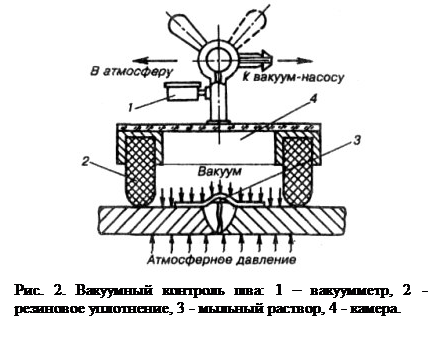
Vacuum control expose welds that cannot be tested with kerosene, air or water and that can only be accessed from one side. It is widely used to check the welds of the bottoms of tanks, gas holders and other sheet structures. The essence of the method is to create a vacuum on one side of the controlled area of the weld and register on the same side of the weld the penetration of air through the existing leaks. Control is carried out using a portable vacuum chamber, which is installed on the most accessible side of the welded joint, previously moistened with soapy water (Fig. 2).
Depending on the shape of the controlled product and the type of connection, flat, angular and spherical vacuum chambers can be used. To create a vacuum, they use special vacuum pumps.
Luminescent control and control by the method of paints, also called capillary flaw detection, is carried out using special liquids that are applied to the controlled surface of the product. These liquids, which have a high wetting ability, penetrate into the smallest surface defects - cracks, pores, lack of penetration. Luminescent control is based on the property of some substances to glow under the influence of ultraviolet radiation. Before checking the surface of the seam and the heat-affected zone, they are cleaned of slag and contaminants, a layer of penetrating liquid is applied to them, which is then removed, and the product is dried. To detect defects, the surface is irradiated with ultraviolet radiation - in the places of defects, traces of liquid are detected by glow.
Paint control It consists in the fact that a wetting liquid is applied to the cleaned surface of the welded joint, which, under the action of capillary forces, penetrates into the cavity of defects. After its removal, white paint is applied to the surface of the seam. Protruding traces of liquid indicate the location of defects.
Control by gas-electric leak detectors and are used for testing critical welded structures, since such leak detectors are quite complex and expensive. Helium is used as the indicator gas. Possessing a high penetrating ability, it is able to pass through the smallest discontinuities in the metal and is recorded by a leak detector. In the process of control, the weld is blown or the internal volume of the product is filled with a mixture of tracer gas with air. The gas penetrating through leaks is captured by a probe and analyzed in a leak detector.
The following control methods are used to detect hidden internal defects.
Magnetic control methods based on the detection of magnetic stray fields formed in the places of defects during the magnetization of controlled products. The product is magnetized by closing the core of the electromagnet with it or by placing it inside the solenoid. The required magnetic flux can also be created by passing current through the turns (3 - 6 turns) of the welding wire wound on the controlled part. Depending on the method of detection of scattering fluxes, the following methods of magnetic control are distinguished: magnetic powder method, induction and magnetographic. In the magnetic powder method, dry magnetic powder (scale, iron filings) or a suspension of magnetic powder in a liquid (kerosene, soap solution, water - wet way). Over the location of the defect, accumulations of powder will be created in the form of a correctly oriented magnetic spectrum. To facilitate the mobility of the powder, the product is lightly tapped. With the help of magnetic powder, cracks invisible to the naked eye, internal cracks at a depth of no more than 15 mm, metal delamination, as well as large pores, shells and slag inclusions at a depth of no more than 3–5 mm are revealed. With the induction method, the magnetic flux in the product is induced by an alternating current electromagnet. Defects are detected using a seeker, in the coil of which, under the influence of a stray field, an EMF is induced, causing an optical or sound signal on the indicator. With the magnetographic method (Fig. 3), the stray field is fixed on an elastic magnetic tape tightly pressed against the joint surface. The record is reproduced on a magnetographic flaw detector. As a result of comparing the controlled connection with the standard, a conclusion is made about the quality of the connection.
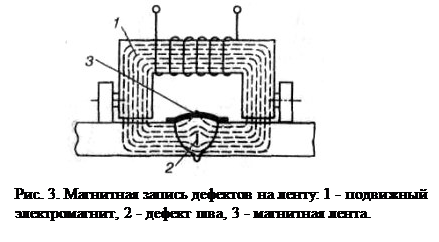
Radiation control methods are reliable and widely used methods of control based on the ability of X-ray and gamma radiation to penetrate the metal. The detection of defects in radiation methods is based on the different absorption of X-ray or gamma radiation by metal sections with and without defects. Welded joints are translucent with special devices. On one side of the seam, a radiation source is placed at some distance from it, on the opposite side, a cassette with a sensitive film is pressed tightly (Fig. 4). During transmission, the rays pass through the welded joint and irradiate the film. In places where there are pores, slag inclusions, lack of penetration, large cracks, dark spots form on the film. The type and size of defects is determined by comparing the film with reference images. X-ray sources are special devices (RUP-150-1, RUP-120-5-1, etc.).

It is expedient to reveal defects in details up to 60 mm thick by X-ray transillumination. Along with radiography (exposure to film), fluoroscopy is also used, i.e. obtaining a signal about defects when metal is translucent on a screen with a fluorescent coating. Existing defects in this case are considered on the screen. This method can be combined with television devices and control can be carried out at a distance.
Radioactive isotopes such as cobalt-60, thulium-170, iridium-192, etc. serve as a radiation source when welding joints are translucent with gamma radiation. An ampoule with a radioactive isotope is placed in a lead container. The technology for performing transillumination is similar to x-ray transillumination. Gamma radiation differs from X-rays in greater rigidity and shorter wavelength, so it can penetrate the metal to a greater depth. It allows you to shine through metal up to 300 mm thick. The disadvantages of transillumination with gamma radiation compared to x-rays are the lower sensitivity when translucidating thin metal (less than 50 mm), the inability to control the intensity of the radiation, and the greater danger of gamma radiation in case of careless handling of gamma devices.
Ultrasonic control is based on the ability of ultrasonic waves to penetrate the metal to a great depth and reflect from the defective areas located in it. In the process of control, a beam of ultrasonic vibrations from a vibrating probe plate (piezocrystal) is introduced into the controlled seam. When it encounters a defective area, the ultrasonic wave is reflected from it and captured by another probe plate, which converts the ultrasonic vibrations into an electrical signal (Fig. 5).
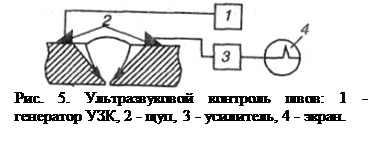
These oscillations, after their amplification, are fed to the screen of the cathode-ray tube of the flaw detector, which indicate the presence of defects. The nature of the pulses is used to judge the extent of defects and the depth of their occurrence. Ultrasonic testing can be carried out with one-sided access to the weld without removing the reinforcement and pre-treatment of the weld surface.
Ultrasonic testing has the following advantages: high sensitivity(1 - 2%), allowing to detect, measure and locate defects with an area of 1 - 2 mm2; high penetrating power of ultrasonic waves, allowing you to control parts of large thickness; the ability to control welded joints with a one-sided approach; high performance and no bulky equipment. A significant disadvantage of ultrasonic testing is the difficulty in establishing the type of defect. This method is used both as the main type of control, and as a preliminary one, followed by transillumination of welded joints with X-ray or gamma radiation.
3. Control methods with the destruction of welded joints
These methods of quality control of welded joints include mechanical tests, metallographic studies, special tests in order to obtain the characteristics of welded joints. These tests are carried out on welded samples cut from the product or from specially welded control joints - technological samples made in accordance with the requirements and technology for welding the product under conditions corresponding to the welding of the product.
The purpose of the tests is: to assess the strength and reliability of welded joints and structures; assessment of the quality of the base and filler metal; assessment of the correctness of the chosen technology; assessment of the qualifications of welders.
The properties of the welded joint are compared with the properties of the base metal. The results are considered unsatisfactory if they do not meet the specified level.
Mechanical tests are carried out in accordance with GOST 6996-66, which provides for the following types of tests of welded joints and weld metal: testing of the welded joint as a whole and the metal of its various sections (deposited metal, heat-affected zone, base metal) for static tension, static bending, impact bending, aging resistance, hardness measurement.
Control samples for mechanical testing perform certain sizes and shapes.
Static tensile tests determine the strength of welded joints. Static bending tests determine the plasticity of the joint by the magnitude of the bending angle before the formation of the first crack in the tension zone. Static bending tests are carried out on samples with longitudinal and transverse welds with the weld reinforcement removed, flush with the base metal. Tests for impact bending, as well as rupture, determine the impact strength of the welded joint. Based on the results of determining the hardness, the structural changes and the degree of hardening of the metal during cooling after welding are judged.
The main task of metallographic studies is to establish the structure of the metal and the quality of the welded joint, to identify the presence and nature of defects. Metallographic studies include macro- and microstructural methods for the analysis of metals.
With the macrostructural method study macrosections and metal fractures with the naked eye or with a magnifying glass. Macro-examination allows to determine the nature and location of visible defects in different zones of welded joints.
In microstructural analysis the structure of the metal is examined at a magnification of 50 - 2000 times using optical microscopes. Microexamination allows you to establish the quality of the metal, including detecting metal burnout, the presence of oxides, contamination of the weld metal with non-metallic inclusions, the size of metal grains, changes in its composition, microscopic cracks, pores and some other structural defects. The technique for making thin sections for metallographic studies consists in cutting samples from welded joints, grinding, polishing and etching the metal surface with special etchants. Metallographic studies are supplemented by hardness measurements and, if necessary, chemical analysis of the metal of welded joints. Special tests are carried out in order to obtain the characteristics of welded joints, taking into account the operating conditions of welded structures: determination of corrosion resistance for structures operating in various aggressive environments; fatigue strength under cyclic loading; creep during operation at elevated temperatures, etc.
Methods of control with the destruction of the product are also used. In the course of such tests, the ability of structures to withstand the specified design loads is established and destructive loads are determined, i.e. actual margin of safety. When testing products with destruction, their loading scheme must correspond to the operating conditions of the product during operation. The number of products subjected to tests with destruction is established by the technical specifications and depends on the degree of their responsibility, the production organization system and the technological maturity of the design.
Destructive control methods include methods for testing control samples in order to obtain the necessary characteristics of a welded joint.
These methods can be used both on control samples and on segments cut from the joint itself. As a result of destructive control methods, the correctness of the selected materials, selected modes and technologies is checked, and the qualification of the welder is assessed.
Mechanical testing is one of the main methods of destructive testing. According to their data, it is possible to judge the compliance of the base material and the welded joint with the technical specifications and other standards prescribed in the industry.
Mechanical tests include:
― testing of the welded joint as a whole in its various sections (deposited metal, base metal, heat-affected zone) for static (short-term) tension;
- static bending;
— impact bending (on notched specimens);
― on firmness against mechanical aging;
― measurement of metal hardness in various parts of the welded joint.
Control samples for mechanical testing are welded from the same metal, by the same method and by the same welder as the main product.
In exceptional cases, control samples are cut directly from the controlled product. Sample options for determining the mechanical properties of a welded joint are shown in fig. 6.

Static stretch test the strength of welded joints, yield strength, relative elongation and relative narrowing. Static bending is carried out to determine the plasticity of the connection by the magnitude of the bending angle before the formation of the first crack in the stretched zone. Static bending tests are carried out on samples with longitudinal and transverse welds with the weld reinforcement removed, flush with the base metal.
impact bend- a test that determines the impact strength of a welded joint. Based on the results of determining the hardness, one can judge the strength characteristics, structural changes in the metal, and the stability of welds against brittle fracture. Depending on the technical conditions, the product may be subjected to impact rupture.
Conclusion
It should be noted that among the listed control methods there is no one that would guarantee the detection of all welding defects. Each of these methods has its own advantages and disadvantages. For example, when using radiation testing methods, volumetric defects of a small size (0.1 mm or more) are quite confidently detected, and non-melting, cracks and tightened lack of penetration (~ 35-40%) are much worse. The ultrasonic method, on the contrary, is more sensitive to planar defects and is ineffective in the control of structures with defects in the form of pores of 1 mm or less. To detect surface defects, either capillary or magnetic control methods are used.
Practice shows that the correct organization of control processes, as well as the skillful application of one or another method or combination of methods during control, make it possible to assess the quality of welded joints with great reliability.
And to eliminate defects in welds, the following methods are used:
The incompleteness of the seams is eliminated by surfacing an additional layer of metal. In this case, the surface to be welded must be thoroughly cleaned to a metallic sheen with an abrasive tool or a metal brush. Excessive reinforcement of the seam is removed using an abrasive tool or a pneumatic chisel. Lack of penetration, craters, porosity and non-metallic inclusions are eliminated by punching out with a pneumatic chisel or by clearing the entire defective area with an abrasive tool, followed by welding. Often used is the smelting of a defective area with a surface oxygen or air-arc cutting torch. Undercuts are welded with thin rolled seams. The sags are eliminated by processing with an abrasive tool or using a pneumatic chisel. External cracks are eliminated by cutting and subsequent welding. Holes are drilled at the ends to prevent crack propagation. Crack cutting is performed with a chisel or cutter. The cutting edges are cleaned from slag, metal spatter, scale and welded. Seams with internal cracks are cut down and brewed again. If there is a network of cracks, the defective area is cut out and a patch is applied instead of welding.
List of sources used
1. Defects and quality control of welded joints http://www.shtorm-its.ru/rus/info/svartech/w23.php
2. Welding quality control http://www.elfplast.ru/welding/quality/
3. Quality control of welding works. http://www.biysk.ru/~zimin/00100/00085.html
4. Destructive testing methods for welded joints http://www.techno-sv.ru/kontrol-svarki2.html
The quality of the weld directly affects the reliability of the entire element, this is especially important for parts experiencing increased or load-bearing loads. Therefore, for quality control, after the main work, an inspection is carried out in order to identify defects. There are many ways to diagnose, which are divided into
- destructive
- non-destructive.
The former imply mechanical or other impact on the weld, in order to identify its errors. In this case, part or all of the welded area loses its structural properties.
For this reason, non-destructive methods for testing welds are considered more popular and appropriate, which we will discuss below.
At the moment, the following non-destructive methods are distinguished:
- visual inspection;
- radiation method;
- magnetic research;
- ultrasonic method;
- capillary method;
- permeability control.
Visual inspection
Any quality control of welded joints begins with a simple visual inspection. This is sufficient to identify both external and internal gaps, plus there is no need to use non-destructive testing equipment. For example, different seam heights may indicate lack of penetration in different areas. Before inspection, the seams are cleaned of technological contaminants, namely, slag, scale and metal splashes.

Visual inspection of the weld
To make minor flaws more visible, surface treatment is carried out alcohol solution and then with 10% nitric acid solution. After this procedure, the surface will become dull and show pores and cracks.
The main thing is not to forget to clean the acid with alcohol after troubleshooting the seam.
Inspection is the main way to identify geometric deviations, such as pores, cracks, sags, undercuts. It is possible to carry out this test item more qualitatively with the help of additional devices.
To do this, it is best to use a magnifying glass, as well as better lighting, preferably with a mobile light source. A magnifying glass will allow you to detect cracks and pores hidden from the eye, as well as trace their path. To control the width of the rollers, you can use measuring instruments, such as a ruler or caliper.

Instruments for visual-measuring control
Radiation flaw detection
The radiographic method for testing welded joints exists in two variations:
- x-ray radiation;
- gamma radiation.
The simplest method presented to identify weld errors is to illuminate the product with X-rays. They have the ability to penetrate metal objects, while acting on the film. Thus, the resulting image is a direct map of most of the defects. With the help of penetrating rays, slag inclusions, gas pores, edge displacements, burns and other gaps are revealed.

Slag inclusions on x-ray
Before starting work, the area to be examined and the adjacent plane must be properly cleaned. To do this, remove slag, spatter, scale and other flaws. Also, before transillumination, an inspection is mandatory, and if poor-quality areas are identified, they must be eliminated.
It is forbidden to start transillumination in the presence of external defects, since the procedure is intended for diagnosis and detection of hidden defects.
If errors are found, the decision to admit or modify a particular part lies with the regulatory documentation. It is the established rules and instructions that make it possible to determine the occurrence of errors in the standards established for a given product. 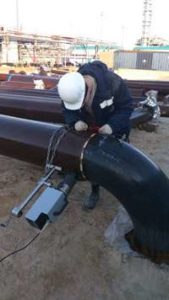
For the procedure, the x-ray tube is positioned so that the beam hits the seam at a right angle. On the other side of the product is a cassette with x-ray film. Since existing defects have less effect on X-ray transmission, they will be visible as darker areas on the film. The radiographic test lasts depending on - film quality, thickness and focus. After the film is developed and you can see the result of welding.
Radiographic control does not reveal:
- any discontinuities and inclusions with a size in the direction of transmission less than twice the sensitivity of the control;
- lack of penetration and cracks, the opening plane of which does not coincide with the direction of translucence;
- any discontinuities and inclusions, if their images in the images coincide with images of foreign parts, sharp corners or sharp changes in cracks in the translucent metal.
Gamma - radiation according to the principle of operation practically does not differ from x-rays. These are radioactive rays that can penetrate metal and react to its unevenness. In this way, I inspect from 10 to 25% of all seams, if the design is responsible, then all seams.
Various sources are used as a source of radiation. chemical elements suitable for certain metals:
- Cobalt - 60 (steel, cast iron, copper, bronze and brass up to 25 cm thick), due to its hard penetration, the element is suitable for most steels and large thicknesses;
- Cesium - 137 (steel up to 10 cm);
- Iridium-192 (steel up to 5 cm, aluminum up to 10 cm);
- Thulium-170 (steel and aluminum up to 20 cm).
With a decrease in penetration, the appearance of alloys and their thickness decrease, but at the same time, the average image quality remains and allows you to determine the main defects.
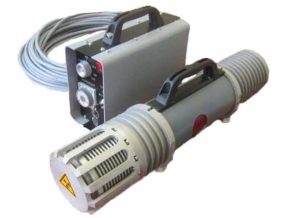
Portable X-ray machine MART-250
Unlike x-rays, gamma rays have several advantages:
- isotopes remain functional for a long time;
- lighter equipment;
- the possibility of troubleshooting complex assemblies;
- increased permeability of rays;
Important! Both types of radiation are extremely dangerous for humans. That is why only specially trained employees dressed in a full set of protective equipment can have access to work. The location and operation of penetrating equipment must also be protected; lead plates, screens and other means are used for these purposes.
Magnetic flaw detection
Such control of welded joints is based on the property of magnetic field lines to respond to changes in the thickness of the metal. By fixing such deviations with special instruments, it is possible to find errors in the thickness and on the upper part of the alloys with high accuracy.

At the moment there are three variations of the method:
- magnetic powder;
- magnetic induction;
- magnetic-graphic.
Powder consists in the fact that a dry powder or emulsion is applied to the surface, going beyond the joint of the seam, then the alloy is magnetized and inaccuracies are determined. If the “dry method” is taken, then iron scale or oxides act as a powder. Magnetize the product with an electromagnet, solenoid or by applying current to the product. After, lightly tapping with a hammer, give the powder
opportunity to take a position. Excess is removed with a stream of air and then flaws are fixed. The last step is demagnetization.
In the wet method, magnetic powder is mixed with kerosene or a special oil. The resulting suspension is applied to the seam, and its mobility, scattering or accumulation of powder are direct identifiers of errors.
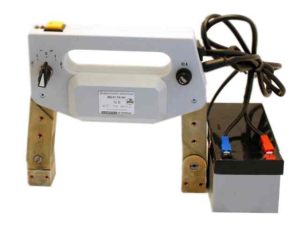
Magnetic flaw detector
With the induction method, all data is recorded by an induction coil. Special devices - flaw detectors, fix magnetic scattering in metals up to 25 mm thick.
Graphic consists in fixing magnetic fluxes on a special tape. It is attached along the seam, and then the deviations are determined on the screen of the cathode ray tube.
Magnetic methods are suitable only for ferromagnetic alloys; other metals cannot be investigated in this way.
Ultrasonic control method
Along with the previous method, ultrasonic flaw detection makes it possible to fix deviations resulting from the reflection of waves from the boundaries of media with different properties. 
The ultrasonic source sends out a signal, which is reflected when the end of the alloy is reached. If a signal encounters a defect on its way, then this is reflected on the wave, which in turn is recorded by the device. Different defects have their own reflections, so determining the nature of the defect is quite simple.

Ultrasonic flaw detector
Of the methods already described, this one is considered the most convenient to use. This is due to the ability to determine the flaw both on the surface and in the depth of the metal. Also, the method does not have such strict limitations as magnetic. There are a number of metals with large grains, such as cast iron, which are not amenable to ultrasonic examination, but for all other alloys, welding quality control can be easily carried out.
There is another drawback - the complexity of decoding the received data. Alas, flaw detectors give the user very specific data that should be decoded. It is almost impossible to do this without preliminary preparation, therefore a trained specialist is needed for the work.
Capillary flaw detection
This method is based on the properties of liquids with low surface tension. Such liquids do not clump into large drops in one place and tend to drain, but at the same time they are able to fill the smallest grooves and holes. Similarly, surface defects and, in rare cases, through channels are determined.

Capillary flaw detection
A special solution is applied to the seam, which instantly fills all the grooves, pores and other minor defects. Then, examining the seam, you can find large flaws. For greater convenience, liquids are tinted with a dye, luminescent and other coloring additives are added.
Weld quality control for permeability
The method is a logical continuation of the capillary method. The basic idea is that by using liquids with deep penetrating properties it is possible to define through grooves in a joint.
To do this, they take simple kerosene, apply it on one side of the seam, and wet spots are fixed on the other, signaling through channels. Of the shortcomings, it is worth noting the need for thorough surface cleaning and accuracy at all stages to prevent accidental contamination of the opposite side of the weld.
Conclusion
Welding and quality control of welded joints of metal structures are inseparable parts of one process. It doesn’t matter whether work is carried out at home or at work, without a proper strength test, the product cannot continue to exist. The methods described above will allow you to check the quality of welded joints without destroying the seam.




